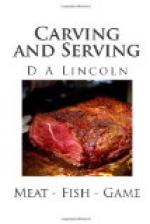A game-carver has a small, narrow, pointed blade; but the shape and length of the handle is the distinguishing feature. The handle should be long enough to reach from the tip of the forefinger to an inch beyond the back side of the hand, so that the edge of the hand about an inch above the wrist rests against the handle of the carver. In dividing a difficult joint, the manipulation should be made, not by turning the hand, but by turning the knife with the fingers. In this way the position of the point of the blade can be more easily changed as the joint may require. The handle of the carving-knife supports the hand of the carver.
Game-scissors have handles like scissors; the two short blades are quite deeply curved, something like the blade of a pruning-knife, making the cutting-power greater. This enables the person using them to cut through quite large bones in tough joints which would otherwise be quite difficult to separate.
Another form of jointer has two blades, one shorter than the other, and a round handle divided the entire length, with a spring in the end next the blade. When the handle is closed, the blades are together and the outer edge of the longer blade is used like a knife for cutting the meat. By opening the handle the curving edges of the blades are used like scissors for cutting the bones.
There are various styles of steels or knife-sharpeners, but the one now in my possession is the best I have ever seen.
It is a four-sided bar of steel, about three eighths of an inch wide and thick, and eight inches long, having the four sides deeply grooved, thus making the edges very prominent. These edges are so sharp that but little pressure of the knife on the steel is required. The handle has a large guard to protect the left hand from the edge of the blade.
But few people know how to use a steel properly. It is difficult to describe the process,—so easy to a natural mechanic and so awkward to others,—or to instruct one in the knack of it, by mere description. Hold the steel firmly in the left hand. Let the edge of the knife near the handle rest on the steel, the back of the knife raised slightly at an angle of about 30 deg.. Draw the knife along lightly but steadily, always at the same angle, the entire length of the blade. Then pass the knife under the steel and draw the other surface along the opposite edge of the steel, from the handle to the point, at the same angle. Repeat these alternate motions the entire length of the blade, not on the point merely, until you have an edge.
Some persons prefer to turn the knife over, drawing it first from the left hand and then toward it, sharpening each surface alternately on the same edge of the steel. This is more difficult to do, as you cannot so surely keep the blade at the same angle,—and this is the most important point. If held at any other than the proper angle, either no edge is made, or it is taken off as soon as obtained.




